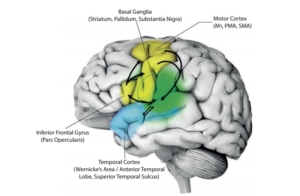Processes and verbs of doing, in the brain: Theoretical implications for systemic functional linguistics
Functions of Language
García, A. M. & Ibáñez, A. (2016). Processes and verbs of doing, in the brain: Theoretical implications for systemic functional linguistics. Functions of Language 23(3), 305-335. Online: http://bit.ly/2fHBdhk.
En términos de la Lingüística Sistémico-Funcional, los “verbos del hacer” (aquellos que denotan acciones físicas sobre el entorno) se distinguen de otras clases de palabras en sus propiedades semánticas, sintácticas y distributivas. En este trabajo se reseña evidencia sobre la organización neurocognitiva de estos verbos y se propone una extensión del esquema teórico de dicha escuela lingüística.
Para acceder al artículo hacé click AQUÍ
Processes and verbs of doing, in the brain: Theoretical implications for systemic functional linguistics
Functions of Language
García, A. M. & Ibáñez, A. (2016). Processes and verbs of doing, in the brain: Theoretical implications for systemic functional linguistics. Functions of Language 23(3), 305-335. Online: http://bit.ly/2fHBdhk.
Systemic functional linguistics (SFL) has long been characterized by its permeability to interdisciplinary contributions. However, it has remained virtually uninformed by neuroscience. Such a disconnection has become all the more unfortunate since SFL ventured into the cognitive domain (Halliday & Matthiessen 1999). Opening a new avenue of disciplinary interaction for SFL, this paper reviews experimental studies on the neurocognitive basis of processes and verbs of doing, highlighting their theoretical implications for cognitive modeling within SFL. Available data corroborates the SFL assumptions that these processes and verbs are (i) conceptually different from participants and nouns, (ii) functionally distinguishable from other process and verb types, and (iii) non-arbitrarily related to each other. Moreover, the evidence shows that (at least some of) the conceptual distinctions within semantics are naturally grounded in more basic (motor and perceptual) neurocognitive distinctions. This, we propose, calls for an elaboration of the stratified SFL model via the inclusion of a sensorimotor stratum. More generally, the article seeks to foster an empirically sound and theoretically relevant dialogue between SFL and promising approaches within cognitive neuroscience.
To access the full paper please click here



